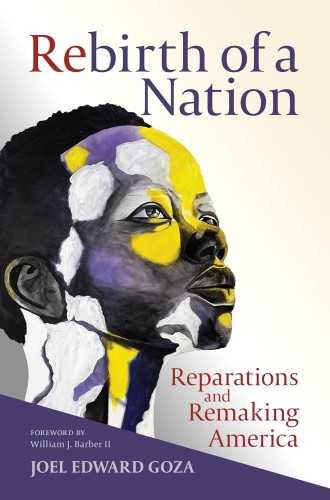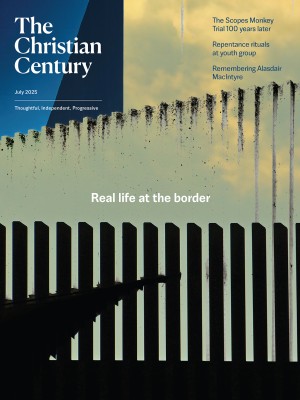Racism by law
Joel Edward Goza shows how White supremacy has used legislation to structure the social reality of the United States.

Rebirth of a Nation
Reparations and Remaking America
Joel Edward Goza’s new book is an exceptional contribution to the growing genre of anti-racist histories. While it necessarily traverses some familiar pathways, the level of depth achieved in this concentrated detailing of key figures demonstrates undeniably how the ideology of White supremacy has been baked into our national culture. Simultaneously, Goza’s unique legislative focus allows readers to experience more fully how past projects continue to create the context for present realities. Ultimately this book provides a North Star toward a better future, highlighting the need for repentance and repair—and beginning the work.
Because the genre of anti-racist history has been expanding in the last decade, perhaps by now we all know something of the inherited lies we need to unlearn. Goza facilitates this unlearning by charting White supremacy’s insidiousness in popular culture and showing how it has structured the social reality of the United States through each generation’s legislation. To do this work, Goza frames his examination around key White male power brokers—in popular culture and in politics—and dives deeply into both their intimate logic and their expansive reach. Thomas Jefferson, Abraham Lincoln, Thomas Dixon (author of The Clansman), Madison Grant (architect for eugenics), and Ronald Reagan provide the pillars for understanding the cultural scene of White supremacy and the creation of its legislative house which we continue to inhabit today.
Read our latest issue or browse back issues.
We see anew not only Jefferson’s personal entanglement in the project of slavery but his contribution to US culture’s enduring anti-Blackness. Similarly, by detailing Lincoln’s lesser known “Proclamation of Amnesty and Reconstruction,” Goza expands our understanding of this complex figure who “appeased the Southern power structure even at the expense of Black dignity.” Demonstrating how White supremacy was the “broken bedrock” on which the nation was built, Goza artfully portrays how lies and caricatures became White America’s common sense. Through intellectuals like Grant and popular novelists like Dixon, readers are offered a window into the mythmaking that shaped White America’s racist imagination through the early 20th century. Highlighting policymakers in this cultural drama, Goza persuasively demonstrates a recurring pattern in the United States of the “deadly political art of deferring racial justice.”
While generations of educators have truncated our understanding of White supremacy in US history by elevating the civil rights movement as a triumphant end, Goza’s deep investigation weaves together the rise of Ronald Reagan and the demise of Martin Luther King’s dream for democracy, thus refusing any premature celebration. Instead, Rebirth of a Nation asks us to see how the continuing patterns of a White supremacist nation evacuated the real possibilities for cultural change that King and his companions pursued. Goza writes, “As the nation rejected King’s vision to increasingly embrace Reagan’s racial rationality, the memory of King and the radical transformation that was possible faded. . . . What would America look like if she had repented of the triple evils of racism, materialism, and militarism” that King denounced? Deep and critical analysis of Reagan’s economic program in California helps us to feel the effects of “a White supremacy agenda” when explicit racism is no longer the lexicon of public political speech. As Goza uncovers the potent blend of racism, corporate capitalism, and the political power of White Christianity throughout a so-called color-blind era, his analysis helps us to tune into White supremacy’s present-day dog whistles.
In addition to chronicling the struggle for and against White supremacy, Rebirth of a Nation makes a critical intervention by placing the United States within an international story. Goza presses readers to consider: Has the US ever been a city on a hill? Or were we always creating the prototype for Nazi Germany? In accounting for the sins of White supremacy, is the US system better or worse than South African apartheid? However we move toward answers, Goza makes one thing powerfully clear: In contrast to international competitors in inhumanity, the United States has never truly faced its White supremacy problem. Here Goza presents the reparative projects Germany and South Africa have pursued. By contrast, failing to confess our national sins, White America has been free to repeat them.
In Goza’s estimation, the time is up for the deferral of responsibility. Indeed, careful readers of the book will be hard-pressed not to see that slavery, lynching, prison, and poverty all demand reparations for Black Americans. In Goza’s skillful analysis, we can see that today’s White resistance to reparations is part of a diseased refusal to take responsibility for Black suffering inflicted in both the past and the present. In refusing reparations, our moment, too, participates in the long US history of deferring racial justice.
The book’s readability, legislative focus, depth of analysis, and comprehensiveness make it powerful, a worthy addition to our anti-racism reading lists. We need more books like Goza’s that might foster this decade’s “new Jim Crow” moment, when scholarship works to create a sea change in Americans’ attitudes toward the institutionalized racial harms in our nation. Offering a significant contribution toward that change, Goza presses readers toward repentance and repair with a bold strategy of reparations that might come as an “aha” moment for the nation. Rebirth of a Nation is an excellent place to begin the work of the “reparative age” its author announces.





